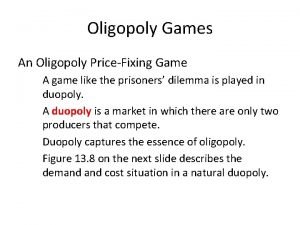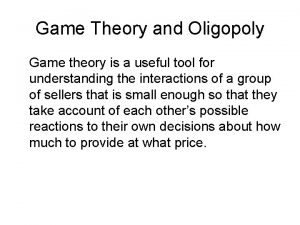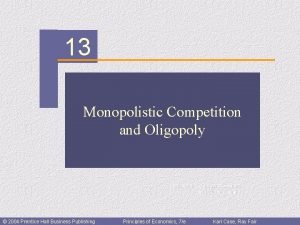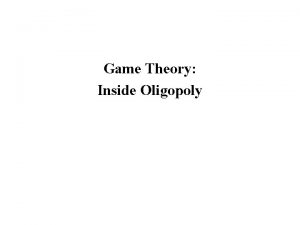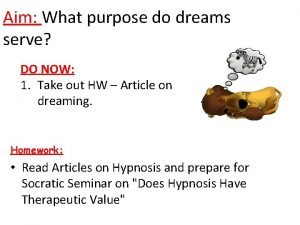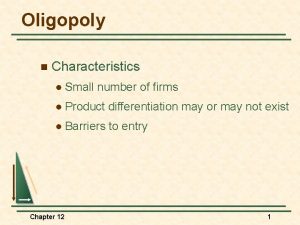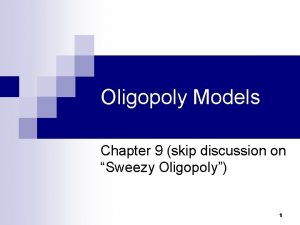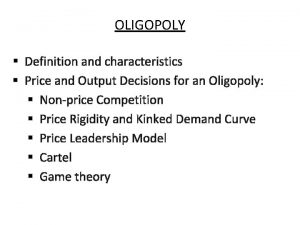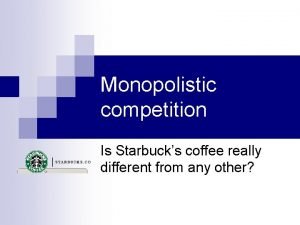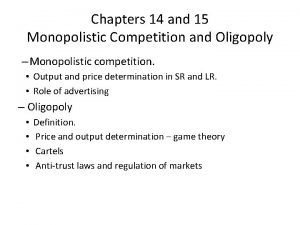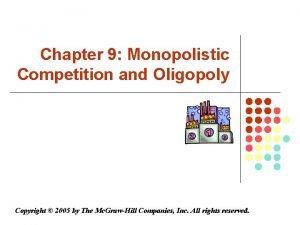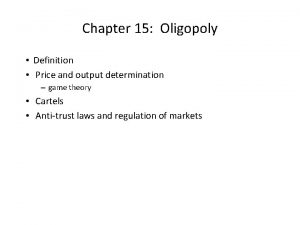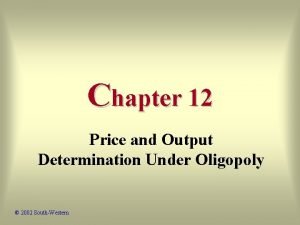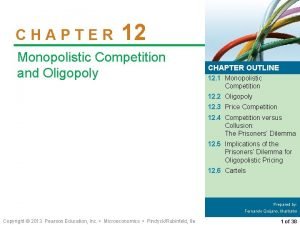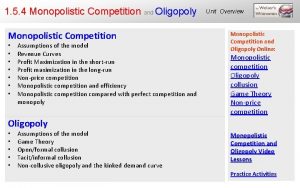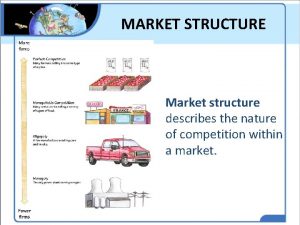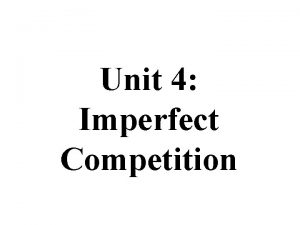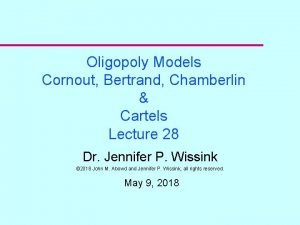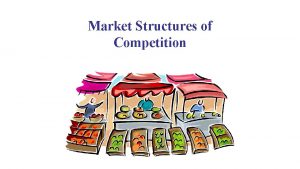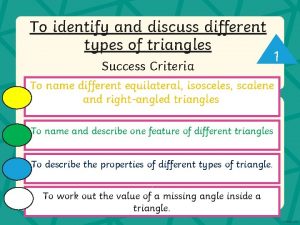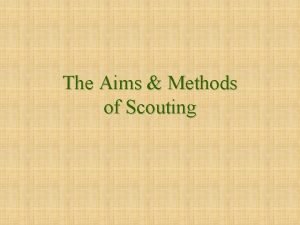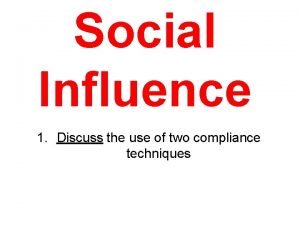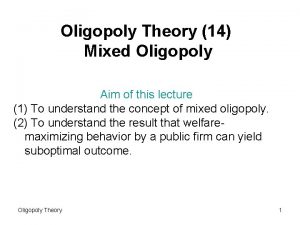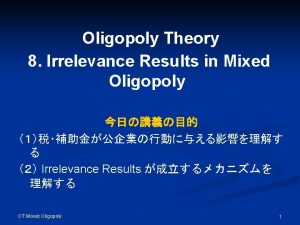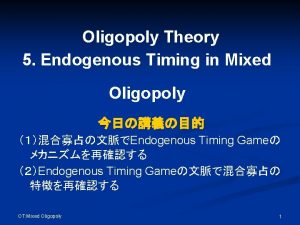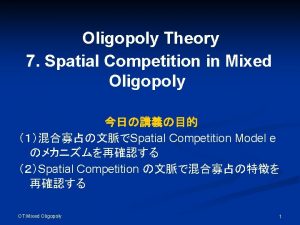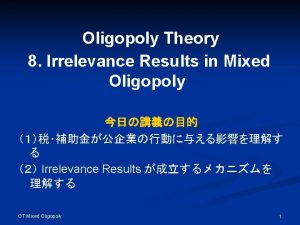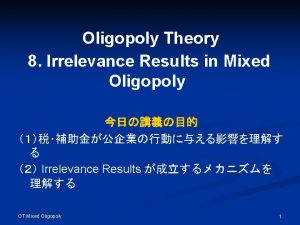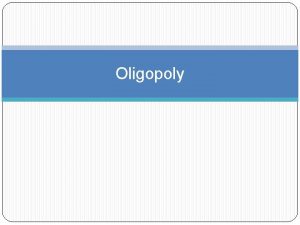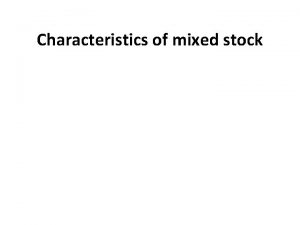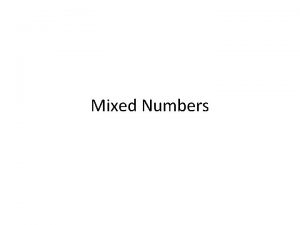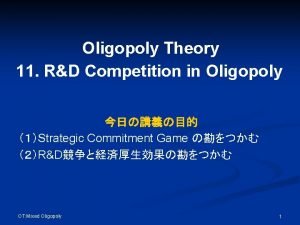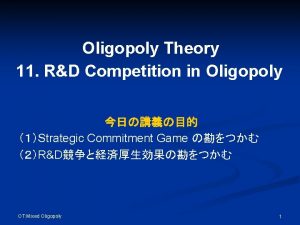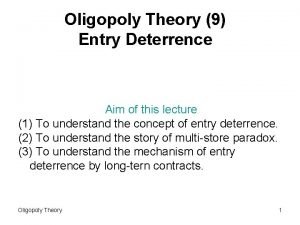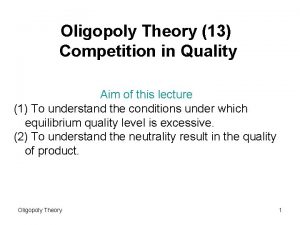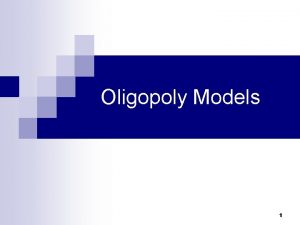Oligopoly Theory 14 Mixed Oligopoly Aim of this





































































- Slides: 69

Oligopoly Theory (14) Mixed Oligopoly Aim of this lecture (1) To understand the concept of mixed oligopoly. (2) To understand the result that welfaremaximizing behavior by a public firm can yield suboptimal outcome. Oligopoly Theory 1

Plan of the presentation (1) Mixed Oligopoly (2) Classical Discussion of Public Enterprises (3) Welfare-Improving Privatization (4) Three Typical Model Formulations of Mixed Oligopoly (5) Partial Privatization (6) Inter Competition (7) Public and Private Leaderships, Endogenous timing (8) Multiple Public Enterprises (9) Privatization Neutrality Theorem (10) Other topics Oligopoly Theory 2

Mixed Oligopoly, Mixed Market State-owned public firms compete against private firms Oligopoly Theory 3

Examples of mixed oligopoly in Japan Banking: Postal Bank, DBJ, Iwate Bank Housing Loan: the Public House Loan Corporation Private Funds: DBJ, Industrial Revitalization Corporation of Japan Life Insurance: Postal Life Insurance (Kampo) Overnight Delivery: Japan Post Energy: Public Gas Corps (Narashino, Fukui, . . . ) Broadcasting: NHK Oligopoly Theory 4

Examples of mixed oligopoly in other countries Banking: Postal Banks (New Zealand, U. K. , Germany, . . . ) Automobiles: Renault, VW Medicine: Public Institute in Brazil Defense, Aviation: EADS, Airbus Airline: airlines (Swiss, Belgian, France, . . . ) Overnight Delivery: USSP Energy: Electricite de France, Gas de France Broadcasting: BBC Oligopoly Theory 5

Differences between public and private firms (1)Public firms are less efficient than private firms. →Many empirical works do not support this view (and many other papers do support this view). (2) Difference of objective function →Private firms maximize their own profits, whereas public firms might care about social welfare. Oligopoly Theory 6

Classical discussions of public firms Why do public firms exist? (1) Natural monopoly (a) Public firm monopoly (b) Regulated private firm monopoly Oligopoly Theory 7

Natural Monopoly P D AC 0 Oligopoly Theory Y 8

Classical discussions of public firms(2) Why do public firms exist? (2) Unprofitable market (a) Public firm monopoly (b) Private firm monopoly with subsidy (compensation of deficit from public funds) Oligopoly Theory 9

Non-Profitable Market P AC D 0 Oligopoly Theory Y 10

Classical discussions on stateowned public firms →Public firm is the monopolist In real economies, public firms are not always monopolists. Public firms do not always face significant economy of scale, which guarantees monopoly by the public firm. Oligopoly Theory 11

Problem(1) How to provide incentives for welfare maximization? → This is the central issue for the public firm's monopoly If we assume that the public firm is a welfaremaximizer under the monopoly, it is absolutely obvious that the first best is achieved by definition. →no unsolved research problem. Thus, researchers never assume that the public firm is a welfare maximizer when they consider monopoly situation. Oligopoly Theory 12

Problem(2) Is the welfare-maximizing behavior by the public firm efficient? →This problem never appears in the public firm's monopoly. This question makes sense in mixed oligopoly because welfare-maximizing behavior by the public firm might worsen welfare through strategic interaction between public and private firms. →This is the central issue of mixed oligopoly Oligopoly Theory 13

Issues of mixed oligopoly ・Is welfare-maximizing behavior by the public firm desirable in mixed oligopoly ? ・What distortion does welfare-maximizing behavior by the public firm yield ? Oligopoly Theory 14

De Fraja and Delbono(1989) (1) Cournot-type (quantity-setting competition, simultaneous-move, no product differentiation) (2) No cost difference between public and private firms. (3) Linear demand quadratic cost function. (4) The private firm maximizes its own profits given outputs of other firms. (5) The public firm maximizes social welfare given outputs of other firms. →The public firm chooses its output level so that the price equals to its marginal cost. Oligopoly Theory 15

Results Compare the pure economy (after the privatization) to the mixed economy (before the privatization) →Privatization of the public firm might improve welfare WP >WM or WP<WM. WP >WM more likely takes place when the number of private firms are large. Oligopoly Theory 16

Intuition (1) Privatization of the public firm reduces public firm's output q 0 (2) Privatization increases each private firm's output q 1 →production substitution from the public firm to the private firms. (3) Privatization decreases total output q 0 +nq 1 Effects (1) and (3) reduces welfare and effect (2) improves welfare. Effect (2) may be the strongest, leading to an improvement of welfare. (2) is stronger and (3) is weaker when m is larger →Privatization morel likely improves welfare when n is larger. Oligopoly Theory 17

Production substitution reaction curve before privatization q 1 reaction curve of the private firm reaction curve after privatization 0 Oligopoly Theory q 0 18

More detailed explanation of intuition Privatization of the public firm reduces q 0 and increases q 1 (production substitution). Before Privatization p=c 0' >c 1' →Public firm's marginal cost is higher than private firm's → Production substitution from public to private economizes production costs →Welfare-improving →Privatization reduces total production level and so consumer surplus → Welfare-reducing It is possible that the former effect dominates the latter effect. Oligopoly Theory 19

Contribution of De Fraja and Delbono(1989) (1) No cost difference between public and private firms → privatization does not improve production efficiency (2) Public firm's objection: welfare →No agency problem in the public firm (3) No additional policies by regulation, tax, or subsidy after privatization. ⇒Ideal circumstances for the existence of public firm. Against assumptions for the advocators of privatizations. → Nevertheless, privatization might improve welfare Oligopoly Theory 20

Assumptions of De Fraja and Delbono(1989) Many researchers in this field believe that the assumptions above are plausible, but many other researchers (as well as I) make these assumptions for strategic purposes. (1) Even without cost differences, privatization improves welfare. →If public firm is less efficient, much more. (2) Even without any agency problem in the public firm, privatization improves welfare. →If public firm has agency problem, much more. Oligopoly Theory 21

Why quadratic costs? Constant marginal cost yields problems If marginal costs are constant and no cost differences exists, the public firm's monopoly yields the first best. → It is nonsense to discuss mixed oligopoly in such a circumstance. Oligopoly Theory 22

How to avoid this problem? (1) Using constant marginal costs and assuming cost differences between public and private firms. Mujumdar and Pal (1998), Matsumura (2003 a), Matsumura and Ogawa (2010) First best is achieved by the marginal cost pricing of the private firm. The private leadership yields the second best where only private firms produce and the price is equal to the marginal cost of the public firm. It is the equilibrium in the observable delay game. Oligopoly Theory 23

How to avoid this problem? (2) Using increasing marginal costs. De Fraja and Delbono (1989), Fjell and Pal (1996), White (1996), Matsumura and Kanda (2005), Heywood and Ye (2009 a), Wang et al. (2009), The paper presented yesterday. If there is no cost difference between public and private firms, at the first best all firms choose the same output level. It is not always achieved in mixed oligopoly since public and private firms have different objectives. Oligopoly Theory 24

How to avoid this problem? (3) Dropping the assumption of homogenous goods. Monopolistic competition: Anderson et al. (1997), Matsumura et al. (2009) Linear demand (quadratic utility function) with product differentiation: Fujiwara (2007) Mill pricing location model: Cremer et al. (1992), Matsumura and Matsushima (2003, 2004), Inoue et al. (2008), Delivered pricing location model: Matsushima and Matsumura (2003, 2006), Heywood and Ye (2009 b) Oligopoly Theory 25

How to avoid this problem? More general Costs : Matsumura (1998, 2003 b), Kiyono and Tomaru (2013) Discuss both (2) and (3): Matsumura and Shimizu (2010) Oligopoly Theory 26

Partial Privatization De Fraja and Delbono: The public sector holds whole shares in the firm (nationalization) or the private sector holds whole shares in the firm (privatization) In the real world, we observe many firms with mixture ownership (partial privatization) NTT, JT, Iwate Bank, Hokuriku Electric Power Company, VW, Renault Oligopoly Theory 27

Matsumura (1998) (1) Cournot-type (quantity-setting competition, simultaneous-move, no product differentiation) (2) No restrictions on the cost differences between public and private firms. (3) The objective function of the public firm is the weight sum of social welfare and its own profits. ( Partial Privatization) U 0 = (1 -α) W + απ0 (4) General demand general costs. The government chooses s and s affects α. After observing α firms compete in the product market. Oligopoly Theory 28

Results α =0 is optimal only if it yields public monopoly. →If we allow partial privatization, no privatization (full nationalization) never becomes optimal. Oligopoly Theory 29

Intuition (1) Suppose that α =0. A slight reduction of α reduces public firm's output q 0. Since p=c 0', this effect is negligible (second order) ←envelope theorem (2) Reducing α increases private firm's output q 1 Since p>c 1', this effect is nonnegligible (first order) ⇒(2) dominates (1). Oligopoly Theory 30

Partial Privatization Free Entry: Matsumura and Kanda (2005), Wang et al. (2010) Product Differentiation: Fujiwara (2007) Spatial Model: Lu and Poddar (2007) Environmental Policy: Kato (2006), Ohori (2006) Anti-Trust: Barcena-Ruiz and Garzon (2003) Labour Market: Beladi and Chao (2006) Subsidization: Tomaru (2006) Endogenous Timing: Matsumura and Ogawa (2010), Barcena-Ruiz and Garzon (2010) Oligopoly Theory 31

Optimal degree of privatization If we adopt partial privatization approach, we can investigate the optimal degree of privatization (optimal degree of α. Optimal degree of privatization depends on (i) the number of private firms (ii) the degree of foreign penetration (iii) cost difference between public and private firms (iv) existence of other policy instruments such as taxsubsidy policy and shadow cost of public funding (vi) Competition structure (free entry, role of public firm and so on) Oligopoly Theory 32

Optimal degree of privatization Suppose that firms face Cournot competition. Optimal degree of privatization is increasing in the number of private firms. It is decreasing in the foreign penetration in product markets in the short run, and the result is inversed in the long-run. The latter result is robust because it does not depend on the strategic substitutability in product markets. Oligopoly Theory 33

Foreign Competitors Public firm maximizes domestic welfare →The public firm's behavior is dependent on whether its rivals are domestic or foreign If the rivals are foreign, the public firm becomes more aggressive. Fjell and Pal (1996)←De Fraja and Delbono (1989) Pal and White (1998) ← Strategic Trade Policy Mukherjee and Suetrong (2009) ← FDI Chang (2005), Chao and Yu (2006), Fujiwara (2006) ← partial privatization version Oligopoly Theory 34

Existing Works Partial Privatization: Both public and private sectors own semipublic (partially privatized) firms. All existing works on partial privatization in mixed oligopoly assume that all owners are domestic in semipublic firms. In contrast, many works allow that pure private firms are foreign. Why asymmetry? ←quite unnatural. We allow that owners of the partially private firm are both foreign and domestic. Lin and Matsumura (unpublished) Oligopoly Theory 35

Private Leadership, Public Leadership Consider a duopoly model with quantity competition under strategic substitutes. Consider two Stackelberg models. One is Public Leadership (the public firm is the Stackelberg Leader) and the other is Private Leadership (the public firm is the Stackelberg follower). Oligopoly Theory 36

Private Leadership The public firm plays a passive role as a potential competitor of the private firm. The public firm supplies only when the private firm's supply is insufficient. ~ Public firm plays a complementarity role of the private sector. This role is intensively discussed in Canada and in Japan (when Koizumi was prime minister) Oligopoly Theory 37

Public Leadership The public firm leads the private sector, a positive role. The public firm produces less under public leadership than under simultaneous production of public and private firms. Oligopoly Theory 38

Endogenous Role Consider the observable delay game. There are two possible time periods for output choice. In the first stage, firm i simultaneously chooses whether it likes to be the leader (ti=L) or the follower (t=F). If two players' choices are consistent, i. e. , one chooses to be the leader and the other does to be the follower, they get the equilibrium payoffs of a agreed timing Stackelberg. Otherwise, they receive the equilibrium payoffs in Cournot. Oligopoly Theory 39

Desirable Role, Endogenous Role Pal (1998): When the private firm is domestic, the private leadership is better than the public leadership and it is an equilibrium in the observable delay game. Matsumura (2003 b): When the private firm is foreign, the public leadership is better than the private leadership and it is an equilibrium in the observable delay game. Oligopoly Theory 40

Assumptions of single public firm Most existing works consider models with single public firm. If this single public firm is privatized, the market becomes pure market economy. Oligopoly Theory 41

Assumptions of single public firm Considering desirable reform of the economic system in former communist transitional countries, this is not a plausible assumption. In reality numerous public firms exist in such countries and it is politically impossible to privatize all of the public firms at the same time. Considering large scale privatization program in traditional mixed economies, one privatization does not yield pure market economy (because substantial public firms remain after the privatization of several firms). →Existing works cannot analyze these markets effectively. Oligopoly Theory 42

Examples of economies with multiple public firms (1) Former communist transitional countries (examples) Russia, Many of Eastern and Central European countries, China, Vietnam, Mongolia. . . (2) Developing, recently developed, and emerging countries (examples) Brazil, India, Iran, Indonesia, Thailand, Korea, Taiwan. . . Oligopoly Theory 43

Examples of economies with multiple public firms (3) Successful privatization programs in developed countries (examples) UK, Japan, Germany, Australia, NZ (4) Traditional mixed economies in developed countries (examples) Japan, France, Germany, Korea Oligopoly Theory 44

Why did existing works consider models with single public firm? If no cost differences between public and private firms exists, obviously N = m yields the first best outcome. →Full nationalization of the economy (complete communist economy) yields the first best. → It is nonsense to discuss mixed oligopoly under such assumptions. But the result (complete communist economy yields the first best) is so unrealistic and implausible. Oligopoly Theory 45

The assumption of no cost difference between public and private firms (1) Strategic assumption. (Even if no cost difference, privatization can improve welfare. ) →Much more if cost difference exits. (2) Realistic assumption. (In mixed market, the public firm faces tough competition with private firms. If the public firm is extremely less efficient than private firms, it would not be able to survive. ) Oligopoly Theory 46

The assumption of no cost difference between public and private firms If m = N (pure planned economy), no competitive pressure exists and the assumption of no cost difference is not plausible. →Restricting attentions to single public firm and avoiding the nonsense result that the first best is achieved by pure nationalized economy. Oligopoly Theory 47

Approach of Matsumura and Shimizu (2010) Suppose that the economy has 100 firms and 25 of them are public firms. Then the number of public firms becomes 24, 23, 22, . . . by privatization. What happens in the process of this privatization? We believe that it is worth discussing this problem. We dare to deviate from the traditional single public firm model. Oligopoly Theory 48

Matsumura and Shimizu (2010) m state-owned public firms compete against N-m private firms. N firms face Cournot competition. Each public firm maximizes welfare, while each private firm maximizes its own profits. Quadratic costs: C = 0. 5α(qi)2 + K (public firm), C = 0. 5β(qi)2 + K (private firm), α ≧ β Our main concerns: Relationship between m and welfare. Oligopoly Theory 49

Result 1 (1) W(m) is decreasing if the public firms are significantly less efficient than the private firms. (W is total social surplus, consumer surplus + profits of firms. m is the number of public firms) If public firms are sufficiently less efficient than the private firms, privatization improves welfare regardless of m and N Oligopoly Theory 50

Result 1 W 0 Oligopoly Theory m (the number of public firms) 51

Result 2 (2) W(m) is increasing if the cost difference between public firms and private firms are sufficiently small and the total number of firms N is small. The government should improve the competitiveness of the market before privatizing the public firms. Oligopoly Theory 52

Result 2 W 0 m (the number of public firms) Oligopoly Theory 53

Result 3 (3) W(m) is U-shaped if the cost difference between public firms and private firms are sufficiently small and N (the total number of firms) is large. This is the most interesting case Oligopoly Theory 54

Result 3 W 0 Oligopoly Theory m (the number of public firms) 55

Even if privatization does not improve welfare at the early stages, it can eventually lead to a point such that privatizations after that point on are beneficial to the society W 0 Oligopoly Theory m 1 m 56

Larger scale privatization programs eventually more likely end up with great success W 0 Oligopoly Theory m 3 m 2 m 1 m 57

Welfare-gains of privatizations is accelerating W 0 m 3 Oligopoly Theory m 2 m 1 m 58

Intuition Suppose that m public firms and N - m private firms exist. Suppose that one public firm is privatized. →Production substitutions from the privatized firm to m - 1 public firm and to N - m private firms take place. →The former production substitution reduces welfare and the latter improves welfare. →The latter becomes stronger when m is smaller and N is larger. Oligopoly Theory 59

Implications (1) Failures at early stages do not imply the failure of the whole privatization program (except for highly concentrated markets). →We should evaluate privatization program from the long term viewpoint. (2) Smaller size privatization programs more likely fail. (3) Welfare-gains of privatizations are larger at the latter stage of privatization program. →Once we reach the critical stage, the privatization automatically proceeds with larger support. Oligopoly Theory 60

Privatization Neutrality Theorem: Privatization does not matter under optimal subsidy policy. It implies that if the optimal subsidy policy is adopted, discussing mixed oligopoly or privatization policy does not make sense. Most of the results in mixed oligopoly literature have quite limited implications and importance if this theorem is really robust. Distractive Result, Disaster for researchers in this field. Oligopoly Theory 61

Intuition behind PNT Suppose that all firms are symmetric. Consider the private oligopoly. The first best is achieved when P=ci' (price =marginal cost) ~ all firms choose the same output level It is achieved by the production subsidy s*. Oligopoly Theory 62

Intuition behind PNT Suppose that one firm is nationalized. Suppose that all of remaining firms do not change their output. The nationalized firm, which is welfare-maximizer, never changes its output. All remaining private firms obviously have no incentive to change their outputs. →s* yields the first best outcome in the mixed oligopoly. Oligopoly Theory 63

Condition for PNT When I explain the intuition behind PNT, I do not use any of (1) Private firms are profit maximizers (2) Homogeneous product market, (3) Single public firm and so on. All we use is the condition that the first best is achieved at the symmetric equilibrium, the first best is achieved by the simple unit subsidy, and the pubic firm is welfare maximizer. Oligopoly Theory 64

White(1996) Introducing subsidy policy into the Cournot-type model of De Fraja and Delbono (1989). The government chooses unit subsidy s so as to maximize resulting welfare Results: Privatization affects neither optimal subsidy rate nor resulting welfare →Privatization does not matter under optimal subsidy policy (Irrelevance Results) Oligopoly Theory 65

Subsequent works Poyago-Theotoky (2001): public firms' leadership; Myles (2002): general demand cost functions; Tomaru (2006): partial privatization approach; Hashimzade et al. (2007): product differentiation; Kato and Tomaru (2007): various payoff functions of private firms. Irrelevance result (especially irrelevance result on welfare) is quite robust. General formulation and general result → Matsumura and Okumura (2013) Oligopoly Theory 66

Exception Fjell and Heywood (2004): Privatization is relevant under asymmetric order of moves among private firms. Oligopoly Theory 67

Robustness of PNT Privatization Neutrality Theorem is far from robust: (1) PNT obviously does not hold when there is cost difference between public and private firms. (2) PNT does not hold unless all firms are domestic. ~ Matsumura and Tomaru (2012) (3) PNT does not hold at free entry markets ~Cato and Matsumura (2013) (4) If there is an excess burden of taxation, PNT does not hold. ~Matsumura and Tomaru (2013) (5) PNT does not hold if firms control two or more independent variables Oligopoly Theory 68

Other Topics (1) R&D Competition, Cost-Reducing Investment, Quality-Improving Investment, Patent Race, Strategic Contracting, and so on. (2) Spatial Competition (3) Relationship between Financial and Product Markets Oligopoly Theory 69
 Oligopoly
Oligopoly Oligopoly game theory matrix
Oligopoly game theory matrix Oligopoly game theory matrix
Oligopoly game theory matrix Oligopoly game theory matrix
Oligopoly game theory matrix Game theory inside oligopoly
Game theory inside oligopoly Aim dream theory
Aim dream theory Oligopoly examples
Oligopoly examples Barriers to entry oligopoly
Barriers to entry oligopoly Example of sweezy oligopoly
Example of sweezy oligopoly Market structures venn diagram
Market structures venn diagram Oligopoly definition
Oligopoly definition Is starbucks a monopolistic competition or oligopoly
Is starbucks a monopolistic competition or oligopoly Imperfect competition curve
Imperfect competition curve Characteristics of an oligopoly
Characteristics of an oligopoly Monopoly and oligopoly examples
Monopoly and oligopoly examples Stackelberg oligopoly model
Stackelberg oligopoly model Barriers of entry for oligopoly
Barriers of entry for oligopoly Market structure of oligopoly
Market structure of oligopoly Price fixing definition
Price fixing definition Price and output determination under oligopoly
Price and output determination under oligopoly Oligopoly questions
Oligopoly questions Oligopoly summary
Oligopoly summary Chapter 17 oligopoly
Chapter 17 oligopoly Chapter 17 oligopoly
Chapter 17 oligopoly Cartel microeconomics
Cartel microeconomics Oligopoly vs monopoly
Oligopoly vs monopoly Oligopoly demand curve
Oligopoly demand curve Perfect competition disadvantages
Perfect competition disadvantages Non price competition in oligopoly
Non price competition in oligopoly Chapter 7 section 3 monopolistic competition and oligopoly
Chapter 7 section 3 monopolistic competition and oligopoly Chapter 17 oligopoly
Chapter 17 oligopoly Uber oligopoly
Uber oligopoly Oligopoly board game
Oligopoly board game Conclusion of oligopoly
Conclusion of oligopoly Monopoly vs oligopoly venn diagram
Monopoly vs oligopoly venn diagram Chamberlin oligopoly model
Chamberlin oligopoly model Oligopoly
Oligopoly Coca cola oligopoly
Coca cola oligopoly Cournot model
Cournot model Peter steiner videos
Peter steiner videos Aim portal osu
Aim portal osu Aim of transformer
Aim of transformer Aim triangle
Aim triangle Aims of scouting
Aims of scouting Suffix ation words
Suffix ation words Struktur penulisan airdam
Struktur penulisan airdam Spot welder definition
Spot welder definition That is not all technique
That is not all technique Introduction of fractional distillation
Introduction of fractional distillation Mudaliar commission report
Mudaliar commission report Aim project management
Aim project management Pans-aim (doc 10066)
Pans-aim (doc 10066) Communicative purpose of narrative text
Communicative purpose of narrative text Aim sample
Aim sample Micro teaching skills
Micro teaching skills The aim chemistry
The aim chemistry Aim of kothari commission
Aim of kothari commission Kothari commission 1964-66 on women education
Kothari commission 1964-66 on women education Ifr flight planning
Ifr flight planning Pans aim
Pans aim Legal aid meaning aim and objective
Legal aid meaning aim and objective Filtration objective
Filtration objective Health and social care unit 5 coursework example p2
Health and social care unit 5 coursework example p2 Learning aim c btec business
Learning aim c btec business Unit 14 learning aim d
Unit 14 learning aim d Unit 14 assignment 2 health and social care
Unit 14 assignment 2 health and social care Objective of air pollution
Objective of air pollution Aims and objectives of establishment of pakistan pdf
Aims and objectives of establishment of pakistan pdf Spartan aim
Spartan aim The aim of previewing is
The aim of previewing is

